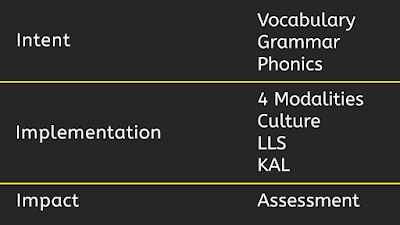The national curriculum for Key Stage 2 (KS2 - age 7-11) Languages is not very long and it’s not as detailed as perhaps we would like. Its purpose of study and the aims sections are the same as for Key Stage 3 (KS3 - age 11-14), but the subject content is different.
In KS3 there is no explicit mention of phonics, although some of the attainment targets need knowledge of phonics and the sound spelling link to be able to do them. For example, students are required to “transcribe words and short sentences that they hear with increasing accuracy” and “speak coherently and confidently, with increasingly accurate pronunciation and intonation”. It is, however. mentioned explicitly in the KS2 national curriculum, implying that the main groundwork needs to be done in primary so that students can hit the ground running and achieve in KS3 and beyond.
First, we can teach any modern or ancient language (so we don’t teach MFL in KS2, but rather FL or just "Languages"). The ancient languages are excused the speaking and therefore the phonics. So children who do Latin in KS2 will be well prepared for modern European languages in KS3 in some ways, but not in others. The second point says “Teaching should provide a balance of spoken and written language”. Historically primary languages were more about speaking and tended to neglect writing, but writing is now a fundamental part of what we do. This is important for phonics, as it shows it’s just as important to be able to say the new sounds as it is to read them and represent them in writing accurately. The aims of the curriculum state that children have to use their knowledge of "phonology, grammatical structure and vocabulary" to enable them to understand and communicate. This is the first mention of the 3 pillars, and something that does not appear in the KS3 curriculum.
Above are the attainment targets that relate to phonics in the KS2 curriculum. It’s all about beginning and developing an understanding of the sounds in the new language and looking into the sound-spelling link. We start to develop accurate pronunciation and intonation, both so that children can speak accurately and be understood, and so that they can read aloud accurately. We are encouraged to use authentic resources such as songs and rhymes to help us to explore phonics, and to help us to make the sound spelling link. Songs and poems are mentioned briefly in KS3 but not with a view to explicitly exploring phonics.
The more I’ve supported other schools with their curricula, the more I have come to realise that the 3 pillars are the Intent of our curriculum. They are what you set out to teach. The four modalities (Listening, Speaking, Reading and Writing), Language Learning Strategies (LLS) and Knowledge About Language (KAL) alongside culture are your Implementation – what you are going to use to teach your intent. Then your Impact is how you assess how well you’ve taught your intent.
So the first answer to the question I posed at the beginning is that the pillar of phonics is firmly embedded in the KS2 curriculum, where the onus is very much on primary teachers to cover phonics systematically and thoroughly, in all four years, so as to enable children to be successful once they enter KS3.
Phonics are best embedded in each lesson, particularly at the initial presentation and practice of vocabulary stage. I choose to teach them explicitly right from the start, not leaving it to chance that the children will notice what I want them to notice. Time is precious in the primary languages classroom, after all. I have started using phonics to introduce new vocabulary, so that the children are seeing the written word at the very first stage and therefore not using English phonics to approximate a spelling of the word in their head, and so that we draw attention to the tricky sounds right from the beginning. Then when it comes to practising the vocabulary with flashcards and images and so on they have already seen the words and are familiar with the sounds. The next stage will be putting the vocabulary into phrases or sentences by way of a sentence builder or similar. Because they are happy with the pronunciation they can focus on the grammar and structure. So the first pillar, phonics, leads to more successful learning of the second pillar, vocabulary, which in its turn leads to increased confidence with grammar and structure.






